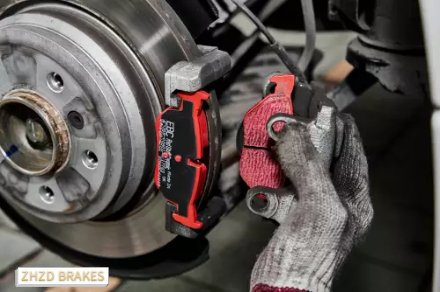Brake pads are mainly divided into the following types: metal brake pads and carbon ceramic brake pads, where metal brake pads are divided into less metal brake pads and semi-metal brake pads, ceramic brake pads are divided into less metal brake pads, and carbon ceramic brake pads are used with carbon ceramic brake discs.
Brake pads are also called brake linings. In the braking system of a car, brake pads are the most critical safety component. Brake pads play a decisive role in all braking effects, so good brake pads are the protector of people and cars. Brake pad replacement depends on how long your pads have been used in the life of your car. You generally need to replace your brake pads after driving more than 80,000 miles. However, if you hear a noise coming from your wheels, you should replace your brake pads no matter how many miles you drive. What types of brake pads are there? What types of brake pads are there?
- Semi-metallic brake pads. Basically, all cars have this formula of brake pads from the factory. Of course this brake pad is also the cheapest drawing. This type of brake pad has a low coefficient of friction, usually 0.38, and has a short service life. Some manufacturers make this brake pad with a high coefficient of friction. Of course, this also has the disadvantage of being prone to noise. Generally in Japanese cars using this kind of brake pad is easy to produce noise. Of course, this is also closely related to the brake disc.
- Metal brake pads are less expensive. The price of this brake pad is slightly higher than that of semi-metallic brake pads. Of course, the performance of this brake pad will also be higher. This formula brake pad is mid-range but not recognized by consumers. In fact, this brake pad is still very cost effective. Of course, it is difficult for consumers to distinguish the difference between this brake pad and semi-metal brake pads, so it is difficult to choose.
- Ceramic brake pads: Different manufacturers use different raw materials for ceramic brake pads, which also leads to the price difference of ceramic brake pads themselves, and the price difference also leads to the advantages and disadvantages of ceramic fiber. Of course, this difference is indistinguishable in the eyes of consumers, and even manufacturers are unable to distinguish whether the quality is good or bad until after they have used them. True ceramic brake pads also contain aramid fibers, which are far superior to the above formula brake pads in terms of service life and brake pad performance. Of course, the price is also more expensive.
- Carbon titanium ceramic fiber: a kind of friction material with carbon fiber as reinforcement material. Carbon fiber has the characteristics of high modulus, good thermal conductivity and heat resistance. In addition to carbon fiber, graphite and carbon compounds are also used in carbon fiber friction materials. The organic binder in the component is also carbonized, so the carbon fiber friction material is also called carbon friction material or carbon titanium friction material.
- High carbon fiber carbon fiber friction material is one of the best friction materials. Carbon fiber friction pads absorb high power per unit area, light specific gravity, especially suitable for the production of aircraft brake pads, some foreign high-grade sports car racing brake pads are also in use. Due to the expensive price, its application is limited.
